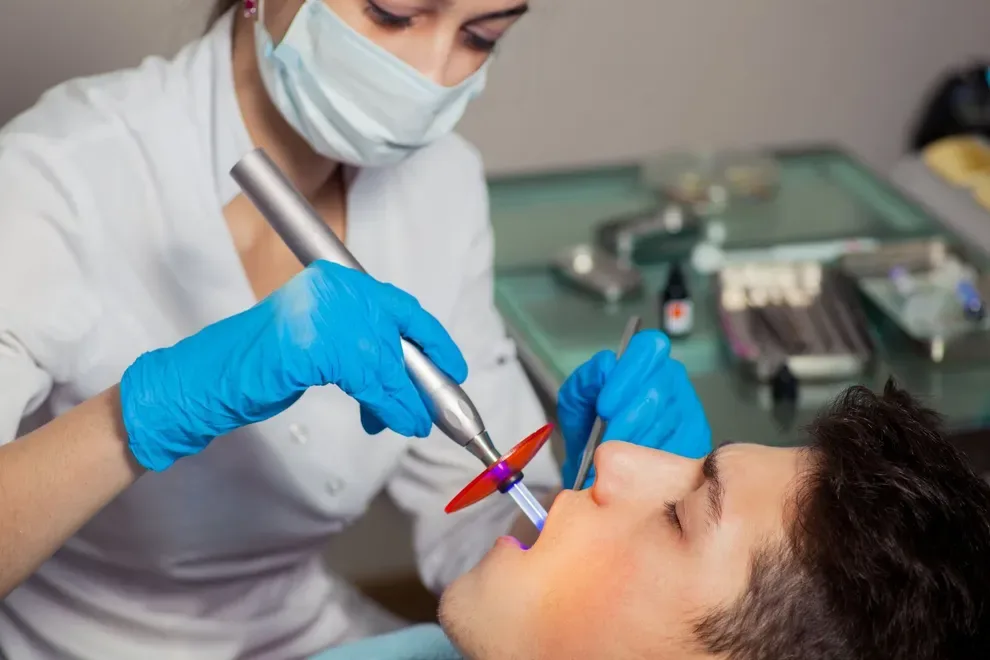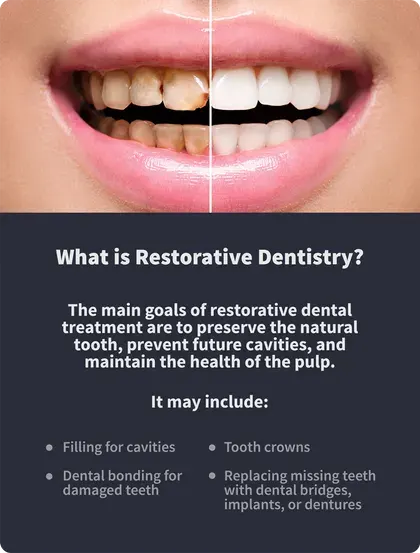Restorative Dentistry: When Is It Needed?

Table of Contents
- What Is Restorative Dentistry?
- The Need
- Costs
- Insurance Coverage
- References
Restorative dentistry is needed to save and restore natural teeth in the event of tooth decay, trauma, disease, injury, or genetic conditions. Restorative dentistry can include many different treatment options and methods, depending on the issue and extent of the damage.
Restorative dentistry is not specifically recognized by the American Dental Association (ADA) as a specialty. Often, general practitioner dentists perform restorative functions.
Restorative dentistry involves any form of repair or restoration to your teeth or oral region. This type of dentistry often focuses on replacing missing teeth and/or replacing or restoring damaged teeth. It can include several dental fields and potentially more than one specialist.
What Is Restorative Dentistry?

Restorative dentistry is often done by general dentists when it involves fixing cracked, broken, or chipped teeth, or teeth that have been damaged by decay. Anything that restores a tooth’s function and look is classified as restorative.
The main goals of restorative dental treatment are to preserve the natural tooth, prevent future cavities, and maintain the health of the pulp.
Restorative dentistry can include the following:
These fill the hole left by a cavity, evening out your tooth and sealing it against further decay. Materials used include composite resin, glass, amalgam, porcelain, or metal.
Like a cap on your tooth, a crown can aid in strengthening the tooth and restoring its shape and size. It is cemented in place. It can be made from a variety of materials, including composite, porcelain, porcelain-fused-to-metal, and metal.
This uses a resin material that is hardened with a UV specialized light to correct chipped, fractured, or broken teeth.
Teeth that need to be replaced require prosthodontics and extensive restorative procedures. Dental implants can replace one tooth. A bridge can fill the gap between a few teeth and will use crowns to attach them on either side. Dentures are removable prosthetic artificial teeth.
Restorative dentistry can encompass the fields of prosthodontics, periodontics, and endodontics. It is different from cosmetic dentistry in that restorative dentistry involves repairing or replacing teeth to improve function, while cosmetic dentistry aims to enhance aesthetics.
The Need for Restorative Dentistry
There can be a number of reasons you may need restorative dentistry, such as these:
Cavities
Broken or chipped tooth
Injury or trauma that damages a tooth
Missing teeth or gaps
Medical or genetic conditions that cause lost or damaged teeth
Dental fillings and crowns are some of the most common forms of restorative dentistry that are done to improve the function and strength of your teeth after tooth decay has been removed. This can also help to prevent further decay.
Dental fillings are used for small cavities and minor tooth fractures. More significant damage will often require more extensive restorative treatment, such as a crown or even an implant.
It is important to keep in mind that restorative dentistry does not include procedures that classify as cosmetic such as veneers or teeth whitening services.
Costs of Restorative Dentistry
Type | Average Cost per Tooth |
Filling | $50 to $300 |
Crown | $500 to over $3,000 |
Dental Bonding | $100 to $1,000 |
Tooth Implants | $3,000 - $4,500 |
Dental Bridges | $2,100 - $4,500 |
Denture | $600 - $3,000 |
The extent of restoration needed will influence the cost. The more damaged your tooth is, the more it is going to cost. Your location, the experience of the dentist, and whether or not you are seeing a specialist are all going to be factors in the final cost.
These are common restorative dental procedures and average costs:
A traditional restorative filling can cost between $50 and $300 on average per tooth.
Depending on the material used, crowns can range from $500 to over $3,000 per tooth on average.
Used to repair a chipped tooth or fill a gap, dental bonding can cost between $100 and $1,000 per tooth on average.
A dental implant will often be restorative and cosmetic. It can cost at least $3,000 to $4,500 per tooth.
These often involve at least three teeth (two each for the crowns, plus the missing tooth gap). The cost of dental bridges can range from at least $2,100 to $4,500 each.
A basic set can cost between $600 and $3,000 on average.
Restorative dentistry can involve preparing the tooth or area ahead of time, such as removing tooth decay. These procedures can add to the overall costs.
Insurance Coverage for Restorative Dentistry
If the need for restoration is considered necessary for medical and functional reasons, and not just for aesthetic purposes, it is generally covered by dental insurance at least partially. The amount of coverage will usually depend on your specific policy and what the procedure entails.
If you choose to have a cosmetic restoration, the procedure will not be fully covered. It may not be covered at all.
Generally, dental insurance will only cover a percentage of the treatment cost. You will often be responsible for at least a copay and a percentage of the cost.
Most dental offices will provide financing options or payment plans to help you. Check with your insurance provider to determine how much of the restorative dentistry they will cover and what you will be responsible for out of pocket.
